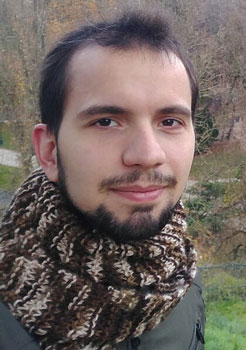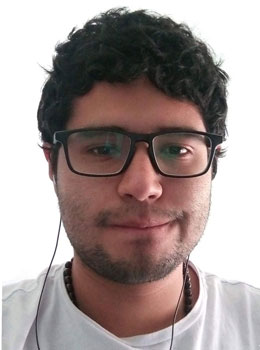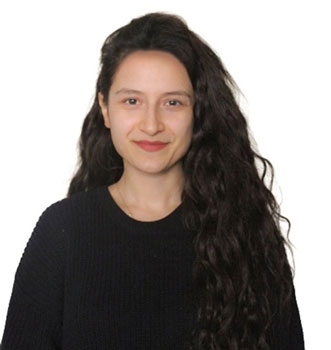List of early stage researchers
further information
-
Ahmed Bayoumi Mahmoud Bayoumi Country of origin: Egypt | Affiliation: Bochum University of Applied Sciences (HBO)

Source: Ahmed Bayoumi Mahmoud Bayoumi
Ahmed Bayoumi Mahmoud Bayoumi comes from Cairo, Egypt. In 2016, he got his bachelor’s degree in Mechanical Power Engineering from Ain Shams University in Cairo, Egypt. his bachelor thesis is ‘’Enhancement of Fuel Combustion in a Gas Turbine Combustor Chamber’’.
After his graduation, he joined the Navy force of the Egyptian Army for one year. In 2020, he got his master’s degree in Mechanical Engineering from Politecnico di Milano in Milan, Italy.
His master thesis is entitled ‘Application of High Cycle Multi-Axial Fatigue Criteria on Bending Fatigue Test’. His aim is to investigate the load ratio of single tooth bending fatigue (STBF) test to meshing gear test using FEM simulations (Abaqus CAE) and application of Crossland fatigue criteria (MATLAB).
In March 2021, Ahmed joined the GW4SHM project and started to work as a PhD researcher in Hochschule Bochum, Germany. His current research interest is Reliability Assessment for Guided Wave-based Monitoring of Pipeline Systems, which focuses on improving methods for the reliability assessment, signal processing and combine experimental with simulation-based data on a specific damage type to provide an adequate information output, that state the reliability of Structural Health Monitoring (SHM) system used. -
Aadhik Asokkumar Country of origin: India | Affiliation: Kaunas University of Technology (KTU)

Source: Aadhik Asokkumar
Aadhik Asokkumar is currently working as a Project Junior Researcher and a PhD student in Prof. K. Baršauskas Ultrasound Research Institute, Kaunas University of Technology, Kaunas, Lithuania. Since October 2020 he is working as one of the Early-Stage Researchers in the GW4SHM project.
In the GW4SHM project, Aadhik is actively researching in the field of Ultrasonic Non-Destructive Testing using guided wave technology where it not only includes development of signal processing algorithms, implementation of artificial neural networks but also the numerical simulation in COMSOL Multiphysics, experimentation with non-contact testing using air-coupled transducers and laser doppler vibrometer.
Prior to joining the GW4SHM project, Aadhik was working in a similar Horizon 2020 project in the Ultrasound institute where his research was focused on air-coupled guided wave tomography.
Before working as a Project Junior Researcher, Aadhik was a student in Dresden International University, Dresden Germany where he received his master’s degree in Non-Destructive Testing by December 2018 and was working as a research assistant in the Chair of Non-Destructive Testing, Saarbrucken, Germany. The master thesis topic “Simulation based key-performance indicator determination in Guided Wave Monitored Metallic Patched Repairs” led him in the direction guided wave testing.
-
Abdul Mateen Qadri Country of origin: Malaysia | Affiliation: Imperial College London (IC)

Source: Abdul Mateen Qadri
Born in Malaysia to a Kashmiri family, Mateen is an Early Stage Researcher in WP1 - Simulation. After completing his Bachelor’s degree at Monash University, he undertook a Master of Engineering Science degree where he focused on developing alternative markers for cardiac dysfunction from 4D Flow MRI data. During his time at Monash, he was a Teaching Assistant for a Master’s/PhD level course on advanced engineering data analysis. He has developed a keen interest in finite element and finite volume methods, and has experience in generating solutions using ANSYS-Fluent, MATLAB and COMSOL.
Mateen joined the GW4SHM project on the 11th of November 2020, and is hosted at Imperial College London. His area of interest in the project is improving finite element modelling for pipe geometries by including analytical approaches for calculating wave modes and dispersion curves. Working closely with partners at SHELL, GUL and TUT, the project is expected to provide a framework enabling highly automated investigation of guided wave reflection performance for user-chosen pipes and defects.
-
André Luiz Dalmora Country of origin: Brazil | Affiliation: French Alternative Energies and Atomic Energy Commission (CEA)

Source: Andre Luiz Dalmora
Born in Brazil, André finished in 2010 his high school and technical studies in “Information Technology”. Since then, he worked as a programmer for private and public companies for seven years, while studying Electrical Engineering at a prestigious Brazilian university, the University of Campinas.
In 2019, he started a master in Acoustical Engineering offered by Institut Polytechnique de Paris and Université Paris-Saclay, in France. He concluded his master with an internship at École Polytechnique in partnership with Saint-Gobain Recherche, developing a finite element tool for simulating room acoustics.
With increasing interest in research he joined the GW4SHM project in September 2020 as a Ph.D. student at the Laboratory of Simulation and Modelling for Acoustics at DISC – CEA List, and at the MΞDISIM Team – Inria, both located at the Plateau de Saclay, France. Related to Guided Waves, his thesis topic is “Modelling and Data Assimilation for Pre-stresses Recovery in the Context of SHM”. This is particularly interesting for Structural Health Monitoring purposes as the structure is subjected to operational and environmental conditions that are related to internal mechanical stresses. -
Daniel Lozano Country of origin: Columbia | Affiliation: Federal Institute for Materials Research and Testing (BAM)

Source: Daniel Lozano
Daniel was born in Bogotá, Colombia, and during his school time he got interest in physics and maths, but from an applied point of view. So, Daniel decided to study Mechanical Engineering and got enrolled at the National University of Colombia.
During his studies, numerical methods and material science caught Daniel’s interest. Afterwards, he had the possibility to travel to Italy for doing master studies at the Polytechnic University of Milan. There he focused on virtual prototyping. In this period Daniel got in touch with engineering tools for simulations as well as with mechanics of composite materials.
In April 2020 he holds his thesis defence titeld ‘Numerical models for the study of bone damage at the multiscale’. After finishing his master, Daniel had the opportunity of participating as PhD student in the GW4SHM project at the Federal Institute of Research and Testing of Materials in Berlin. So, since he started, on the 1st of September, Daniel focusses on modelling of ultrasonic wave propagation using the Scaled Boundary Finite Element Method, the interaction with defects, and how to develop more realistic models in this framework.
-
Emiel Hassefras Country of origin: Netherlands | Affiliation: Netherlands Organisation for Applied Scientific Research (TNO)

Source: Emiel Hassefras
Emiel Hassefras, from the Netherlands, completed his bachelor’s degree in Applied Earth Sciences at Delft University of Technology. Upon completing this degree, he was first introduced to the field of ultrasonics by looking at seismic interferometry as a non-destructive method for wooden panel paintings. From that moment onwards he developed an interest in acoustics and seismology, and continued his education in Delft with the joint master in Applied Geophysics, taught at three different universities TU Delft, ETH Zurich, and RWTH Aachen. Finally, he concluded his studies with a thesis by relating ultrasonic signals to the microstructure of concrete, at the BAM in Berlin.
Following his training, Emiel developed a strong interest in numerical methods. Prior to GW4SHM, he worked at the center for marine environmental sciences. where he investigated the stability of submarine slopes using the finite element method. Emiel joined the GW4SHM project in the beginning of April 2021. The aim of his reseach is to create a robust tomographic inversion algorithm for quantitative sizing of wall loss of metallic as well as delamination of composite structures. An important challenge to be addressed is the non-uniqueness of inverse problems due to a local variation in material parameters or geometry variations. -
Enes Savli Country of origin: Turkey | Affiliation: Fraunhofer Institute for Ceramic Technologies and Systems (IKTS)

Source: Enes Savli
Enes Savli is from Istanbul, Turkey. He holds a Bachelor's degree in Mechanical Engineering from Turkey and an interdisciplinary Master's degree “Modeling for Science and Engineering” which is an applied science program from “Universitat Autonoma de Barcelona”.
A substantial portion of Enes work in general at the graduate level has involved numerical modeling and engineering simulations. During his master Enes worked as research intern in Barcelona Supercomputer Center. His thesis extends a research on “Reduced Order Modelling” methods on large scale parameterized acoustic wave propagation models. Additionaly, he worked in industry more than four years as a CAE Engineer and R&D Engineer. During this time, Enes was I involved projects in automotive, defence and energy industries on subjects of computational mechanics and system simulations.
Enes got involved in GW4SHM project in November 2020 as Early Stage Researcher under the supervison of Dr. Kilian Tschöke at the “Fraunhofer Institute of Ceramic Technologies and Systems” located in Dresden, Germany. His research topic is “Model-assisted Design of Guided Wave-based SHM Systems”. His reseach is aimed on creating an improved and adapted simulation tool for elastodynamic and guided wave propagation in anisotropic and layered media by applying novel numerical methods allowing for simulation-supported reliability studies of Lamb wave-based SHM systems.
-
Ferda Cansu Gül Country of origin: Turkey | Affiliation: Safran Tech. (SAFRAN)

Source: Ferda Gül
Ferda Cansu Gül comes from Istanbul, Turkey. She got her bachelor’s degree in Physics Engineering from Istanbul Technical University (ITU) in 2016 and graduated with a master’s degree in Information and Communication Engineering from Informatics Institute of ITU in December 2019. She started her academic career at the Informatics Institute of Istanbul Technical University as a full-time Research Assistant in 2018. During her master's degree, Ferda studied microwave and millimeter-wave antenna design and numerical methods in electromagnetic by using HFSS, CST, and MATLAB. The subject of the master thesis is “Design of Microstrip Patch Antennas for 5G Mobile Communication Systems”. In September 2020, Ferda joined the GW4SHM project and started to work as a PhD student in the Sensing and Application Department at Safran Tech, in Paris, France. She is also a member of the Pythia Team and PhD student at the Aerospace Structures and Materials department of TU Delft, in the Netherlands. In the GW4SHM project, she mainly focuses on enhancing the Remaining Useful Life (RUL) based on the SHM concept and developing prognostic methods for efficient RUL estimation.
-
Masoud Mohammadgholiha Country of origin: Iran | Affiliation: University of Bologna (UNIBO)

Source: Masoud Mohammadgholiha
Masoud was born in Ghazvin, Iran, in 1992. He earned a Bachelor of Science in Civil Engineering from Bu-Ali Sina University in 2014 and a Master of Science in Structural and Earthquake Engineering from K.N. Toosi University of Technology (KNTU) in 2017. During his MSc dissertation, he worked on the numerical and experimental studies focusing on the combination of MEMS sensors and vibration-based SHM methods for damage detection in infrastructures. He was a recipient of the competitive scholarship awarded by Tehran Urban Research and Planning Center for the duration of his MSc at KNTU. Following his graduation, Masoud was involved as a Research Assistant in a variety of activates at KNTU. The main activity can be divided into three categories: i. Structural health monitoring and control (buildings, bridges, dams), ii. Seismic assessment of infrastructures (machine learning approach, simulation), and iii. Wave propagation and frequency analysis of composite materials. The results of his studies are published in peer-reviewed journals. Since November 2020, he is working as an ESR at the University of Bologna. In the GW4SHM project, Masoud will focus on development of novel piezoelectric transducers, and implementation and validation of novel damage detection algorithms compatible with embedded signal processing.
-
Mohsen Barzegar Country of origin: Iran | Affiliation: Instituto de Telecomunicações (IT)

Source: Mohsen Barzegar
Mohsen was born in the northeastern part of Iran in a Kurdish family. He loves travelling, doing sports like bodybuilding and CrossFit, and he is always accepting new challenges. He received a master’s in aerospace engineering, aeronautical structures from Sharif University of Technology with a thesis on multi-scale modeling of creep analysis in composite structures. After graduation, he collaborated with different research groups and organizations. His interests include, but not limited to structural health monitoring, fracture, and fatigue analysis of adhesively bonded structures as well as composite materials. He joined the GW4SHM from November 16, 2020, and his host organization is Instituto de Telecomunicações, Lisbon, Portugal. Now, his area of research in GW4SHM is structural health monitoring of adhesively bonded structures for different assemblies and materials.
-
Omar Rasgado Country of origin: Mexico | Affiliation: Tallinn University of Technology (TUT)

Source: Omar Rasgado
Omar Rasgado is from Mexico and is very passionate about maths and science. He did his bachelor’s degree in Mechanical Engineering at the University of Veracruz, Mexico. In 2018, Omar was funded by the Mexican government to carry out a master study at Durham University in the United Kingdom. The purpose of this master was to evaluate the potential of a Small-scaled Compressed Air Energy Storage System. During this time, Omar was a full-time research student. His work consisted mainly of modelling and running simulations of thermodynamic systems.
After he finished his M.Sc. degree, Omar wanted to pursue a PhD in a new challenging research area related to numerical methods and its application to on-site engineering problems. The project GW4SHM was the challenge Omar was looking for. Being able to identify damage and corrosion in structures (e.g. pipelines) without on-site inspections and by using sophisticated physics, i.e. guided waves, seemed to be very interesting to him. So, he started his Early Stage Research position in September 2020, at Tallinn University of Technology, Estonia. Guided by his supervisor Madis Ratassepp, Omar is working on Developing Guided Wave Tomography for Anisotropic Waveguides.
-
Panpan Xu Country of origin: China | Affiliation: Imperial College London (IC)

Source: Panpan Xu
Panpan Xu comes from China. She received her Bachelor’s (2016) and Master’s (2019) degree in Aeronautical and Astronautical Science and Technology from Xi’an Jiaotong University in China. Her previous research experience relates to the defects detection of metallic structures using direct current potential drop (DCPD) method and eddy current testing (ECT) method, and the damage evaluation of non-metallic structures using capacitive method. Her master’s thesis focused on the study of the mechanical properties and damage mechanism of polymer composites under biaxial compression. Prior to joining the Imperial College London, Panpan worked at Xi’an Jiaotong University as a research assistant working on the vibration analysis and evaluation using inversion algorithms. Now, Panpan is a PhD student in the Non-Destructive Evaluation Research Group of the Department of Mechanical Engineering at Imperial College London and is supervised by Dr. Peter Huthwaite. She joined the GW4SHM program as an Early Stage Researcher (ESR) in November 2020 and her primary research interest is in estimating the reliability of guided wave SHM systems through numerical modelling.
-
Vivek Nerlikar Country of origin: India | Affiliation: French Alternative Energies and Atomic Energy Commission (CEA)

Source: Vivek Nerlikar
Vivek Nerlikar was born in India, where he completed his initial schooling and undergraduate studies. He got his bachelor’s degree in Industrial and Production Engineering from Visvesvaraya Technological University (VTU) India. After completing his bachelor's, he worked as a design trainee Engineer for seven months in a hydraulic company in India. Later on, he decided to pursue higher education, for that, he applied to the University of Duisburg-Essen for the master’s course in Computational Mechanics and got admitted. The primary focus of the studies was on finite element methods, material modeling, and structural dynamics. During the studies, he also got an opportunity to do an internship at Continental AG Nuremberg, Germany. Here, he acquired exposure to the practical application of structural dynamics in automotive components, such as transmission control units. After the internship, he started his master thesis in the University on “Damage evaluation based on elastic guided waves facilitated by deep learning.” This thesis gave him the first-hand experience of guided waves and artificial intelligence, which paved the way to embark on the GW4SHM project. He began his PhD in October 2020 and is working on “Digital Twin in Structural Health Monitoring for Aerospace using Machine learning” hosted by CEA list, Saclay France. The primary focus of this thesis is to develop a robust methodology for defect identification and sizing.
